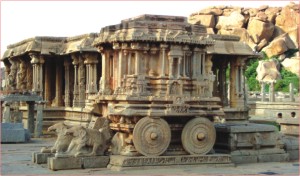Feature
Hampi, the heaven that was carved out of stone
Sabiha Mahmud Sumi
 A village situated in within the rocks of northern Karnataka state in India is the famous historical site of Hampi. Its renowned temples and architectural value makes a place as such more exquisite. The name Hampi, derives from the old name of he Tungabhadra River, Pampa. Hampi was built on the banks of this river and is the former capital of the Vijayanagara Empire. Hampi is located within the ruins of Vijayanagara, and continues to be known as an important religious center as it houses the Virupaksha Temple, the Vithala Temple and a lot of other temples. The village of Hampi also contains several other monuments belonging to the old city. It extends into some of the old ceremonial streets of Vijayanagara. A village situated in within the rocks of northern Karnataka state in India is the famous historical site of Hampi. Its renowned temples and architectural value makes a place as such more exquisite. The name Hampi, derives from the old name of he Tungabhadra River, Pampa. Hampi was built on the banks of this river and is the former capital of the Vijayanagara Empire. Hampi is located within the ruins of Vijayanagara, and continues to be known as an important religious center as it houses the Virupaksha Temple, the Vithala Temple and a lot of other temples. The village of Hampi also contains several other monuments belonging to the old city. It extends into some of the old ceremonial streets of Vijayanagara.
Hampi is known through the historical Kishkindha, the Vanara (monkey) kingdom, as it finds its position in the great tale of Ramayana. The first historical settlements in Hampi date back to 1CE. Hampi formed one of the cores of the capital of the Vijayanagara Empire from 1336 to 1565. It was destroyed by Muslim Sultans. Hampi was chosen to be the capital because of its strategic location, bounded by the torrential Tungabhadra River on one side and surrounded by defensible hills on the other three sides. The site is of great importance in terms of architecture and historical significance. The demography is abundant with large stones which have been utilized to make larger than life stature of god. One can see a structure of historic importance every quarter of a mile. However, this city is in ruins due to invading Islamic aggression that treat Idol worship as blasphemy. Many statuses have been destroyed or damaged and successive governments have not been able to keep the place free from treasure seekers who cause further damage to this city. However, excavations in the area are being continued to discover more artifacts and temples.
Hampi is situated on the banks of the Tungabhadra River. It is 353km away from Bangalore, 254km from Bijapur and 74km away from Bellary. Hosapete, 13km away, is the nearest taluka headquarters. The main languages spoken there are Kannada and Telugu. The principal industries of the village are agriculture, the support of the Virupaksha temple and some other local holy places in the vicinity, and tourism. The splendid remains of palaces and gateways of the broken city tell a tale of men infinite talent and power of creativity together with his capacity for senseless destruction.
The Hampi Bazaar is one of the main sites of Hampi, as it is in the centre of Hampi and is situated on a very beautiful street with very beautiful houses. One of the most important sites of Hampi is the Virupaksha Temple. It rises majestically at the western end of the famous Hampi Bazaar. The temple has 120ft tall tower on its eastern entrance. The temple contains the shrines of Shiva, Pampa and Bhuvaneswari Parts of this temple are older than the Vijayanagara kingdom itself. The work of this style dates back to the 11th or 12th century. Another interesting site would be the 6.7m tall monolith of Ugra Narasimha. This is said to be hewn from a single rock boulder and was built during the reign of Krishnadeva Raya. Of course, the Vithala Temple Complex is definitely one of the most well known sites as it contains 56 musical pillars and to the east of the hall stands the famous Stone Chariot with stone wheels that actually revolve. In front of the shrine stands the great mantapa. These are only some of the main architectures in the city of Hampi as there are about 200 other temples that can be seen while at Hampi.
(The writer is a Bangladeshi student of grade 11, Kodaikanal International School in Tamil Nadu, India)
|
